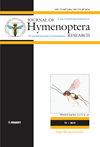New suggestion of the species group reconstruction of genus Nomada Scopoli, 1770 (Hymenoptera, Apidae) from Korea
IF 1.5
3区 农林科学
Q2 ENTOMOLOGY
引用次数: 0
Abstract
Genus Nomada , which includes approximately 800 species, is the largest genus in the subfamily Nomadinae and the sole genus in the tribe Nomadini. Its taxonomic classification is particularly challenging due to high morphological variations, making it one of the most controversial groups in the subfamily. In order to shed light on the complex classification of Nomada species and their tribal position, this study conducted a multi-locus phylogeny using one mitochondrial gene (COI) and five nuclear protein-coding genes (EF1α, Nak, Opsin, Pol Ⅱ, Wingless). The study focused on expanding the knowledge of some East Palearctic species, with the ultimate goal of reviewing species groups of Nomada present in Korea. In this study, we suggest that the ruficornis species group is polyphyletic. Some species should be moved to more appropriate species groups as follows: N. tsunekiana , N. emarginata , and N. flavopicta into the basalis species group; N. aswensis , N. kaguya , and N. taicho into the armata species group.New韩国野田蜂属的种群重建建议,1770(膜翅目,蜂科)
Nomada属包括约800种,是Nomadinae亚科中最大的属,也是Nomadini部落中唯一的属。由于形态的高度变化,其分类分类特别具有挑战性,使其成为亚科中最具争议的群体之一。为了揭示Nomada物种的复杂分类及其部落地位,本研究利用1个线粒体基因(COI)和5个核蛋白编码基因(EF1α、Nak、Opsin、PolⅡ、Wingless)进行了多位点系统发育。本研究的重点是扩大对东古北地区一些物种的认识,最终目的是审查韩国现存的Nomada物种群。在这项研究中,我们认为ruficornis种群是多系的。部分种应移至更适宜的种群,如:海啸北缘藓属(N. tsunekiana)、缺叶北缘藓属(N. emarginata)和黄皮北缘藓属(N. flavopicta)移至基岩藓属(basalis)种群;aswensis, kaguya,和taicho进入armata种群。
本文章由计算机程序翻译,如有差异,请以英文原文为准。
求助全文
约1分钟内获得全文
求助全文
来源期刊
CiteScore
2.60
自引率
15.40%
发文量
68
审稿时长
>12 weeks
期刊介绍:
The Journal of Hymenoptera Research is a peer-reviewed, open-access, rapid online journal launched to accelerate research on all aspects of Hymenoptera, including biology, behavior, ecology, systematics, taxonomy, genetics, and morphology.
All published papers can be freely copied, downloaded, printed and distributed at no charge for the reader. Authors are thus encouraged to post the pdf files of published papers on their homepages or elsewhere to expedite distribution. There is no charge for color.

 求助内容:
求助内容: 应助结果提醒方式:
应助结果提醒方式:


